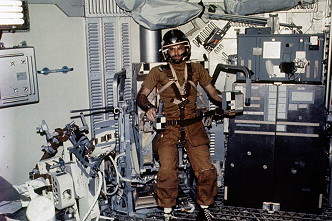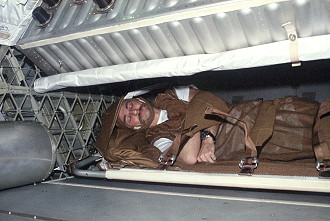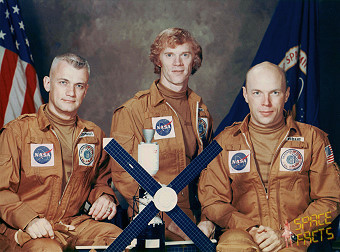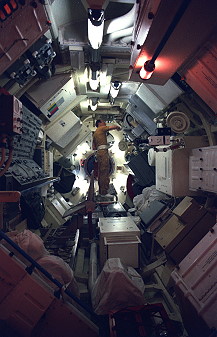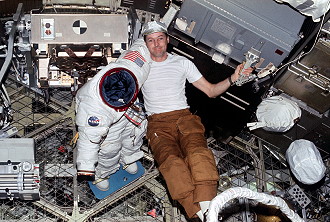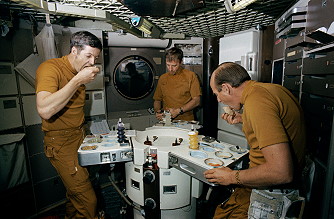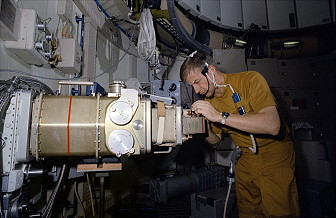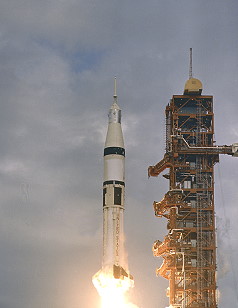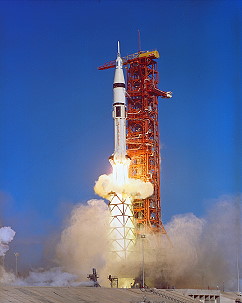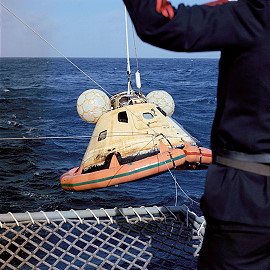....
...While another launch vehicle was scheduled to replace as it's role of Space Station transport (largely due to it's high cost per launch) five Saturn IBs still remained from the original production run and NASA decided not to waste vehicles they had already paid for. It's safety and reliability had proven itself to the crews of Skylab A and Apollo 7. Unlike the Soviet equivalent (the N-11) the Saturn IB continued to serve it's role well after the lunar landings....
While we've had some lively discussion of just what we might expect to see replace the 1B, and even some questions raised about why not just make more, that the 1B is due for replacement is quite obvious to me. (To anyone who has read any of Eyes Turned Skyward the obvious replacement is indeed a Saturn 1C of Goblin/Pi design!

It just works so very well, using the same upgraded Apollo tech your timeline's continued Saturn V derivative program uses.)
No, for me by far the more surprising and disturbing puzzle this passage presented was the implication that the Soviet N-11 is now discontinued! Perhaps I missed something but this takes me totally by surprise, and makes me rather sad too. Sure, both the N rockets had some serious teething issues--but having invested in persistently working through and past them, by now both, the smaller N-11 especially, should be shaking down into quite reliable designs, which the Soviets have had extensive experience in launching.
Furthermore, the N-11 parallels the possible relationship of a your-timeline franchise of the Saturn 1C to an ongoing Saturn V program, in its commonalities with its "big brother," the N-1--but far more so. If the Americans start designing a family of rockets based on the F-1A for the sea level stage and J-2S propelled upper stages, they will benefit from economies of commonality in the engine, and probably adopting the best practices to choose from among the three stages' structural/tankage designs a common design there would be chosen too, leading to a range of rockets tailored to various purposes but turned out and launched with remarkable economy. Well, consider how much greater and more immediately applicable the commonalities between the N rockets already are! Basically an N-11 is simply an N-1 that has had its A stage omitted and had the 8 upper-atmosphere optimized engines of the Beh stage replaced with 8 of the A stage design--and there you are, a 20-ton to orbit range workhorse from the exact same workshop floors as the 75 ton heavy.
Clearly all the talk of possible upgrades of the N-1 casts a bit of a cloud over this cozy relationship continuing; if both of the two upper orbital-boost stages of the N-1, Beh and Veh, were converted to hydrogen-lox engines, then the older kerlox Beh and Veh would become obsolete. An improved hydrogen-burning second stage for the N-11 could clearly be a simple substitution of the more advanced Veh for the older one, but trying to launch with a hydrogen burning first stage will be a difficult threshold for Soviet launch tech to cross.
As many readers here know well but others may not have seen explained before, the big advantage of burning hydrogen with LOX is that it is both among the most energetic combinations possible and produces the lightest products (short of a nuclear rocket with pure hydrogen as the working fluid)--the combination leading to an almost unbeatably high ISP and hence lower fuel mass per delta-V achieved. This sounds absolutely fabulous and it is indeed a big winner for deep space applications, or even the major part of a multistage climb to orbit.
However, for several reasons, good old kerosene-lox is much more strongly competitive with hydrogen-lox than one would think from just measuring ISP, and this is especially the case for a first stage that is fired on the ground and works mainly in the lower atmosphere.
To begin with, the higher the ISP, this means the lower the mass and the faster the speed that mass is expelled, to achieve a given thrust--which is again great in vacuum, but in the lower atmosphere, throwing a relatively small mass hard suffers when that thin though energetic stream meets air at sea level densities. All rockets suffer in performance at sea level, with their products slamming into the dense air, which slows the output stream down and can even cause it to stagnate chaotically. But the higher the ISP, the greater the percentage reduction in effective thrust. So, a ker-lox engine that works well in vacuum will also not work as well at sea level, but if its exhaust nozzle is optimized for the average air density it would encounter as a boost engine, the reduction would be modest. For a hydrogen engine of the same thrust in vacuum however, its sea level thrust would be dramatically lower and the different nozzle design to optimize the thrust would be more drastically different from the vacuum ideal. Therefore the advantage of attempting to attain the higher ISP of hydrogen burning is not as great for a first stage as it is for upper stages.
Secondly, thrust is a very important parameter of any rocket but relatively more important for a first stage than an upper stage. First stage engines must make the entire vast mass of the whole rocket, fuel and payload rise and hustle off the launch pad, and shove them as briskly as possible to higher speeds, and do this while the rocket is deep in Earth's atmospheric soup. It so happens, again I think not by accident, that it is easier to design a big, high thrust rocket using larger masses of less energetic propellant. Compare the maximum thrusts of the ker-lox F-1 and the hydrogen J-2; both represent the limits of the American state of the art in the 1960s. Even if the advantage of using hydrogen did not decline as mentioned above, it would be necessary to use 35 J-2 engines to accomplish the thrust of the 5 F-1!
Third, while hydrogen is the lightest propellant one could desire, it is unfortunately also the least dense--despite the fact that one uses dramatically less of it by mass, that smaller mass requires very large tanks, which must also be heavily insulated, and thus are quite heavy relative to tanks needed for the larger masses of "inferior" fuels--this also poses challenges in meeting the structural requirements of rocket stages and raises the aerodynamic drag, which is mainly a factor in the first stage of launch.
If we are going to compromise and use different propellants for different stages, it is clearly best to put the dense and somewhat prodigal ker-lox in the first stage, where its relative disadvantage is lowest and its practical advantages are most valuable. A first stage will always be by far the most massive, so it is worth trading off making it even more massive for making it compact, simple and structurally efficient, whereas we can much better afford to pay the prices hydrogen demands for its premium values in upper stages, where the prices are lower and the advantages show forth more strongly.
So, the Soviets going over to hydrogen upper stages for N-1 casts a bit of a cloud over the N-11 since the smaller rocket's first stage will presumably have to continue to be the old legacy N-1 Beh stage, not the nifty new hydrogen-burning alternate.
On the other hand, we haven't seen any clear sign just when and even if any of the legacy N-1 stages will actually go over to something along those lines anyway. Even if these are on the agenda and will be the next big reveal on the Soviet side of this ongoing space race, I see no reason the old Beh stage cannot continue to be produced for the first stage of an upgraded N-11. Indeed, mixing and matching ker-lox and hydro-lox design stages can be a viable approach to a modular system of launch vehicles covering a large range of masses to orbit; perhaps with hydro-lox upper stages, the strategy of cutting off the bottom of the N-1 can give them a low-mass to orbit rocket based on the ker-lox Veh stage (with 4, or in an enlarged version 6, of the A stage sea-level optimized engines of course) using new or borrowed hydrogen upper stages, to replace the Semyorka perhaps? Then versions of all three ker-lox legacy stages may continue in production with incremental improvements (in control software mainly, I'm thinking, or perhaps redesigned tankage for drag reduction and greater structural efficiency) while benefiting from extensive experience with the basic design, and carrying over use of already established construction and handling facilities.
This is more or less the course I've imagined the Soviets would follow. Apparently the authors have something else in mind though. I can only wait and hope it would be something promising and awesome enough to justify abandoning the N system that has hitherto served them quite well.


